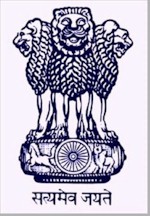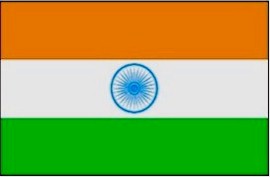India: General Information
History
The history of India is shrouded in antiquity. The country has
been thought of as a nation of philosophers with a well developed and even
idyllic society. Excavations of sites belonging to the Harappan era show that
people lived in brick houses in towns with excellent drainage systems. One of
the oldest scriptures in the world is the four volume Vedas that many regard as
the repository of national thoughts that anticipated some of the modern
scientific discoveries.
Despite formidable barriers in the form of the mighty
Himalayas and oceans, India also received a succession of foreigners, many of
them carrying swords and guns. But nearly all of them stayed on. Out of these
waves of immigration has emerged the composite culture of India and made it a
land of unity in diversity. India became a land of assimilation and learning, a
land of change and continuity. The Aryans were among the first to arrive in
India which was inhabited by the Dravidians. Others who came here included
Greeks, Persians, Mughals, British, Portuguese and French. Over the years there
have been many major ruling dynasties like the Shakas, the Kushans, the Maurayas
and Guptas.
Nearly every major religion in the world is represented in
India which is also the land of the Lord Buddha, Lord Mahavira and Guru Nanak
Dev, the founders of Buddhism, Jainism and Sikhism.
Physical Features
India, with an area of 3.3 million sq. kin, is a subcontinent.
The peninsula is separated from mainland Asia by the Himalayas. The country lies
between 8º4' and 37º6' north of the Equator and is surrounded by the Bay of
Bengal in the east, the Arabian Sea on the west and the Indian Ocean to the
south.
The Himalayas form the highest mountain range in the world, extending 2,500 km
over northern India. Bounded by the Indus river in the west and the Brahmaputra
in the east, the three parallel ranges, the Himadri, Himachal and Shivaliks have
deep canyons gorged by the rivers flowing into the Gangetic plain.
River Systems
The rivers may be classified as follows: The Himalayan rivers,
Rivers of the DeccanPlateau, the coastal rivers and the rivers of
the inland drainage basin. The Himalayan rivers are generally snow-fed and flow
throughout the year. During the monsoon months (June to September), the
Himalayas receive very heavy rainfall and the rivers carry the maximum amount of
water, causing frequent floods. The Deccan rivers are generally rain-fed and,
therefore, fluctuate greatly in volume. A very large number of them are
non-perennial. The coastal rivers, specially on the west coast, are short and
have limited catchment areas. Most of these are non-perennial as well. The
rivers on the inland drainage basin are few and ephemeral. They drain towards
individual basins or salt lakes like the Sambhar or are lost in the sands,
having no outlet to the sea.
Climate
The Himalayan range in the north acts as the perfect
meteorological barrier for the whole country. Despite the country's size and its
varied relief, the seasonal rhythm of the monsoon is apparent throughout.
Although much of northern India lies beyond the tropical zone, the entire
country has a tropical climate marked by relatively high temperatures and dry
winters.
Natural Vegetation
The Himalayan region, which is rich in vegetative life,
possesses varieties that can be found practically from the tropical to tundra
regions. Only the altitude influences the distribution of vegetation. In the
rest of the country, the type of vegetation is largely determined by the amount
of rainfall. Outside the Himalayan region; the country can be divided into three
major vegetation regions: the tropical wet evergreen and semi-evergreen forests,
the tropical deciduous forests, and the thorn forests and shrubs.
People
India is probably the only country with the largest and most
diverse mixture of races. All the five major racial types: Australoid,
Mongoloid, Europoid, Caucasian and Negroid - find representation among the
people of India.
Languages
India has 17 major languages and 844 different dialects. The
Sanskrit of the Aryan settlers has merged with the earlier Dravidian vernaculars
to give rise to new languages.
Hindi, spoken by about 45 per cent of the population, is the
national language. English has also been retained as a language for official
communication.
Indian literature dates back several millennia to the hymns of
the vedic Aryans. The oral tradition nurtured classical literature, and produced
great works of philosophy and religious doctrine. It also accounted for
compilations of anecdotes like the Panchatantra and the Jataka tales, as well as
epics like the Ramayana and the Mahabharata. In southern India, the creative
energies of the Tamil poets found expression in the great works of Sangam
literature. The epic Tirukkural by Tiruvalluvar is a masterpiece of this age. In
the north, dramatists like Kalidasa and Bhasa produced great dramas in Sanskrit.
Religions
Hinduism: The Hindu religion had its origin in the
concepts of the early Aryans who came to India more than 4,000 years ago. It is
not merely a religion but also a philosophy and a way of life. Hinduism does not
originate in the teachings of any one prophet or holy book. It respects other
religions and does not attempt to seek converts. It teaches the immortality of
the human soul and three principal paths to ultimate union of the individual
soul with the all pervasive spirit.
The essence of Hindu faith is embodied in the Lord's Song, the
Bhagavad Gita: "He who considers this (self) as a slayer or he who thinks
that this (self) is slain, neither knows the Truth. For it does not slay, nor is
it slain. This (self) is unborn, eternal, changeless, ancient, it is never
destroyed even when the body is destroyed."
Jainism and Buddhism: In the sixth century before
Christ, Mahavira propagated Jainism. Its message was asceticism, austerity and
non-violence.
At about the same time, Buddhism came into being. Gautama
Buddha, a prince, renounced the world and gained enlightenment. He preached that
'Nirvana' was to be attained through the conquest of self. Buddha's teachings in
time spread to China and some other countries of South-East Asia.
Islam: Arab traders brought Islam to South India in the
seventh century. After them came the Afghans and the Moghuls, among whom the
most enlightened was the Emperor Akbar. Akbar almost succeeded in founding a new
religion Din-e-Elahi, based on both Hinduism and Islam, but it found few
adherents.
Islam has flourished in India through the centuries. Muslim
citizens have occupied some of the highest positions in the country since
independence in 1947.
Sikhism: Guru Nanak, the founder of Sikhism in the 15th
century, stressed the unity of God and the brotherhood of man. Sikhism, with its
affirmation of God as the one supreme truth and its ideals of discipline and
spiritual striving, soon won many followers. It was perhaps possible only in
this hospitable land that two religions as diverse as Hinduism and Islam could
come together in a third, namely Sikhism.
Christianity: Christianity reached India not long after
Christ's own lifetime, with the arrival of St. Thomas, the Apostle. The Syrian
Christian Church in the south traces its roots to the visit of St. Thomas. With
the arrival of St.Francis Xavier in 1542 the Roman Catholic faith was
established in India. Today Christians of several denominations practise their
faith freely.
Zoroastrianism: In the days of the old Persian Empire,
Zoroastrianism was the dominant religion in West Asia, and in the form of
Mithraism, it spread over vast areas of the Roman Empire, as far as Britain.
After the Islamic conquest of Iran, a few intrepid
Zoroastrians left their homeland and sought refuge in India. The first group is
said to have reached Diu in about 766 A.D.
The total number of Zoroastrians probably does not exceed
130,000. With the exception of some 10,000 in Iran, almost all of them live in
India, the vast majority concentrated in Mumbai. The Parsees excel in industry
and commerce, and contribute richly to the intellectual and artistic life of the
nation.
Judaism: Jewish contact with the Malabar Coast in
Kerala dates back to 973 BC when King Solomon's merchant fleet began trading for
spices and other fabled treasures. Scholars say that the Jews first settled in
Cranganore, soon after the Babylonian conquest of Judea in 586 BC. The
immigrants were well received and a Hindu king granted to Joseph Rabban, a
Jewish leader, a title and a principality.
National Anthem
The song Jana-gana-mana, composed by Rabindranath
Tagore, was adopted by the Constituent Assembly as the national anthem of India
on 24 January 1950. It was first sung on 27 December 1911 at the Calcutta
Session of the Indian National Congress. The complete song consists of five
stanzas. First stanza consists full version of the National Anthem. It reads:
Jana-gana-mana-adhinayaka, jaya he
Bharata-bhagya-vidhata.
Punjaba-Sindhu-Gujarata-Maratha
Dravida-Utkala-Banga
Vindhya-Himachala-Yamuna-Ganga
Uchchala-Jaladhi-taranga.
Tava shubha name jage,
Tava shubha asisa mage,
Gahe tava jaya gatha,
Jana-gana-mangala-dayaka jaya he
Bharata-bhagya-vidhata.
Jaya he, jaya he, jaya he,
Jaya, jaya, jaya, jaya he!
Playing time of the full version of the national anthem is
approximately 52 seconds. A short version consisting of first and last lines of
the stanza (playing time approximately 20 seconds) is also played on certain
occasions. The following is Tagore's English rendering of this stanza:
Thou art the ruler of the minds of all people,
dispenser of India's destiny.
Thy name rouses the hearts of Punjab, Sind,
Gujarat and Maratha,
Of the Dravida and Orissa and Bengal;
It echoes in the hills of the Vindyas and Himalayas,
mingles in the music of Jamuna and Ganges and is
chanted by the waves of the Indian Sea.
They pray for thy blessings and sing thy praise.
The saving of all people waits in thy hand,
thou dispenser of India's destiny.
Victory, victory, victory to thee.
CLICK
HERE FOR MUSIC SCORE AND SOUND CLIP OF THE NATIONAL ANTHEM
National Emblem
 |
The National emblem of India is a replica
of the Lion of Sarnath, near Varanasi in Uttar Pradesh. The Lion Capital
was erected in the third century BC by Emperor Ashoka to mark the spot
where Buddha first proclaimed his gospel of peace and emancipation. The
National emblem is thus symbolic of contemporary India's reaffirmation
of its ancient commitment to world peace and goodwill.
The four lions (one hidden from view) - symbolising
power, courage and confidence rest on a circular abacus. The abacus is
girded by four smaller animals guardians of the four directions: the
lion of the north, the elephant of the east, the horse of the south and
the bull of the west. The abacus rests on a lotus in full bloom,
exemplifying the fountainhead of life and creative inspiration. The
motto 'Satyameva Jayate' inscribed below the emblem in Devanagari script
means 'truth alone triumphs'.
|
National Flag
| The Indian flag was designed as a symbol of freedom.
The late Prime Minister Nehru called it "a flag not only of freedom
for ourselves, but a symbol of freedom to all people."
The flag is a horizontal tricolour in equal proportion
of deep saffron on the top, white in the middle and dark green at the
bottom. The ratio of the width to the length of the flag is two is to
three. In the centre of the white band, there is a wheel in navy blue to
indicate the Dharma Chakra, the wheel of law in the Samath Lion Capital.
Its diameter approximates the width of the white band and it has 24
spokes. The saffron stands for courage, sacrifice and the spirit of
renunciation; the white, for purity and truth; the green for faith and
fertility.
|
 |
National Animal - Tiger
 |
The large Asiatic carnivorous feline
quadruped, Panthera tigris, maneless, of tawny yellow colour with
blackish transverse stripes and white belly, proverbial for its power
and its magnificence is the national animal of India.
There are very few tigers left in the world today. A
decade ago the tiger population in India had dwindled to a few hundreds.
The Government of India, under its Project Tiger programme, started a
massive effort to preserve the tiger population. Today, thanks to
Project Tiger, India's population of tigers is in a comfortable
position.
|
National Bird - Peacock
| Male Bird of species P. cristatus, is
a native of India, with striking plumage and upper tail converts marked
with iridescent ocelli, able to expand its tail erect like fan as
ostentatious display. Peacocks are related to pheasants.
Found wild in India (and also domesticated in
villages) they live in jungle lands near water. They were once bred for
food but now hunting of peacocks is banned in India. The peahen has no
plumage. These birds do not sound as beautiful as they look - they have
a harsh call.
|
 |
National Flower - Lotus
 |
The Lotus or waterlily is an aquatic plant of Nymphaea
family with broad floating leaves and bright fragrant flowers that
grow only in shallow waters. The leaves and flowers float and have long
stems that contain air spaces. The big attractive flowers have many
petals overlapping in a symmetrical pattern. The root functions are
carried out by rhizomes that fan out horizontally through the mud below
the water. Lotuses, prized for their serene beauty, are delightful to
behold as their blossoms open on the surface of a pond. In India the
sacred lotus is legendary and much folklore and religious mythology is
woven around it. |
National Tree - Banyan
| Indian fig tree, Ficus bengalensis, whose
branches root themselves like new trees over a large area. The roots
then give rise to more trunks an branches. Because of this
characteristic and its longevity, this tree is considered immortal and
is an integral part of the myths and legends of India. Even today, the
banyan tree is the focal point of village life and the village council
meets under the shade of this tree. |
 |
National Fruit - Mango
 |
A fleshy fruit, eaten ripe or used green
for pickles etc., of the tree Mangifera indica, the mango is one
of the most important and widely cultivated fruits of the tropical
world. It~ juicy fruit is a rich source of Vitamins A, C and D. In India
there are over 100 varieties of mangoes, in different sizes, shapes and
colours. Mangoes, have been cultivated in India from time immemorial.
The poet Kalidasa sang its praises. Alexander savoured its taste, as did
the Chinese pilgrim Hieun Tsang. Akbar planted 100,000 mango trees in
Darbhanga, known as Lakhi Bagh.
|
Reference Source High Commission Of India UK.






